Leishmania Sexual Reproductive Strategies as Resolved through Computational Methods Designed for Aneuploid Genomes
Abstract
1. Introduction
1.1. Clonality vs. Sexuality
1.2. Mosaic Aneuploidy and Parasexuality
1.3. Natural and Experimental Hybrids in Leishmania
2. Methods
2.1. PAINT, a Comprehensive Tool to Decipher Sexual Strategies in Leishmania
2.2. Determining Ploidies
2.3. Finding Single Nucleotide Variations (SNVs) and Determination of Parental Contributions
3. Results
3.1. Demonstration of PAINT Pipeline Using Simulated Datasets
3.2. Determination of Somies Using NGS Alignments
3.3. Determination of Parental Inheritance
3.4. Recombination Detection Using Genetic Maps
3.5. Analysis of Interspecies Hybrids
3.6. PAINT Supports Meiosis-Like Sexual Recombination in Experimental Hybrids
4. Conclusions
Author Contributions
Funding
Data Availability Statement
Acknowledgments
Conflicts of Interest
References
- Akopyants, A.S.; Kimblin, N.; Secundino, N.; Patrick, R.; Peters, N.; Lawyer, P.; Dobson, D.E.; Beverley, S.M.; Sacks, D.L. Demonstration of genetic exchange during cyclical development of Leishmania in the sand fly vector. Science 2009, 324, 265–268. [Google Scholar] [CrossRef] [PubMed]
- Sadlova, J.; Yeo, M.; Seblova, V.; Lewis, M.D.; Mauricio, I.L.; Volf, P.; Miles, M.A. Visualisation of Leishmania donovani fluorescent hybrids during early stage development in the sand fly vector. PLoS ONE 2011, 6, e19851. [Google Scholar] [CrossRef] [PubMed]
- Tibayrenc, M.; Ayala, F.J. Relevant units of analysis for applied and basic research dealing with neglected transmissible diseases: The predominant clonal evolution model of pathogenic microorganisms. PLoS Negl. Trop. Dis. 2017, 11, e0005293. [Google Scholar] [CrossRef] [PubMed]
- Tibayrenc, M.; Kjellberg, F.; Ayala, F.J. A clonal theory of parasitic protozoa: The population structures of Entamoeba, Giardia, Leishmania, Naegleria, Plasmodium, Trichomonas, and Trypanosoma and their medical and taxonomical consequences. Proc. Natl. Acad. Sci. USA 1990, 87, 2414–2418. [Google Scholar] [CrossRef] [PubMed]
- Rougeron, V.; de Meeus, T.; Hide, M.; Waleckx, E.; Bermudez, H.; Arevalo, J.; Llanos-Cuentas, A.; Dujardin, J.C.; de Doncker, S.; Le Ray, D.; et al. Extreme inbreeding in Leishmania braziliensis. Proc. Natl. Acad. Sci. USA 2009, 106, 10224–10229. [Google Scholar] [CrossRef]
- Ramirez, J.D.; Llewellyn, M.S. Reproductive clonality in protozoan pathogens—Truth or artefact? Mol. Ecol. 2014, 23, 4195–4202. [Google Scholar] [CrossRef]
- Akhoundi, M.; Downing, T.; Votýpka, J.; Kuhls, K.; Lukeš, J.; Cannet, A.; Ravel, C.; Marty, P.; Delaunay, P.; Kasbari, M.; et al. Leishmania infections: Molecular targets and diagnosis. Mol. Asp. Med. 2017, 57, 1–29. [Google Scholar] [CrossRef]
- Kuhls, K.; Keilonat, L.; Ochsenreither, S.; Schaar, M.; Schweynoch, C.; Presber, W.; Schönian, G. Multilocus microsatellite typing (MLMT) reveals genetically isolated populations between and within the main endemic regions of visceral leishmaniasis. Microbes Infect. 2007, 9, 334–343. [Google Scholar] [CrossRef]
- Schnonian, G.; Kuhls, K.; Mauricio, I.L. Molecular approaches for a better understanding of the epidemiology and population genetics in Leishmania. Parasitology 2011, 138, 405–425. [Google Scholar] [CrossRef]
- Downing, T.; Imamura, H.; Decuypere, S.; Clark, T.G.; Coombs, G.H.; Cotton, J.A.; Hilley, J.D.; de Doncker, S.; Maes, I.; Mottram, J.C.; et al. Whole genome sequencing of multiple Leishmania donovani clinical isolates provides insights into population structure and mechanisms of drug resistance. Genome Res. 2011, 21, 2143–2156. [Google Scholar] [CrossRef]
- Rogers, M.B.; Downing, T.; Smith, B.A.; Imamura, H.; Sanders, M.; Svobodová, M.; Volf, P.; Berriman, M.; Cotton, J.A.; Smith, D.F. Genomic confirmation of hybridisation and recent inbreeding in a vector-isolated leishmania population. PLoS Genet. 2014, 10, e1004092. [Google Scholar] [CrossRef] [PubMed]
- Malavera, A.P.; Bruno, C.; Fernandez, E.; Balzarini, M. Comparison of algorithms to infer genetic population structure from unlinked molecular markers. Stat. Appl. Genet. Mol. Biol. 2014, 13, 391–402. [Google Scholar]
- Mannaert, A.; Downing, T.; Imamura, H.; Dujardin, J.C. Adaptive mechanisms in pathogens: Universal aneuploidy in Leishmania. Trends Parasitol. 2012, 28, 370–376. [Google Scholar] [CrossRef] [PubMed]
- Sterkers, Y.; Lachaud, L.; Crobu, L.; Bastien, P.; Pagès, M. FISH analysis reveals aneuploidy and continual generation of chromosomal mosaicism in Leishmania major. Cell. Microbiol. 2010, 13, 274–283. [Google Scholar] [CrossRef] [PubMed]
- Bastien, P.; Blaineau, C.; Pages, M. Leishmania: Sex, lies and karyotype. Parasitol. Today 1992, 8, 174–177. [Google Scholar] [CrossRef]
- Barja, P.P.; Pescher, P.; Bussotti, G.; Dumetz, F.; Imamura, H.; Kedra, D.; Domagalska, M.; Chaumeau, V.; Himmelbauer, H.; Pages, M.; et al. Haplotype selection as an adaptive mechanism in the protozoan pathogen Leishmania donovani. Nat. Ecol. Evol. 2017, 1, 1961–1969. [Google Scholar] [CrossRef]
- Sterkers, Y.; Crobu, L.; Lachaud, L.; Pagès, M.; Bastien, P. Parasexuality and mosaic aneuploidy in Leishmania: Alternative genetics. Trends Parasitol. 2014, 30, 429–435. [Google Scholar] [CrossRef]
- Lanotte, G.; Rioux, J.A. Cell fusion in Leishmania (Kinetoplastida, Trypanosomatidae). Comptes Rendus l’Acad. Sci. 1990, 310, 285–288. [Google Scholar]
- Forche, A.; Alby, K.; Schaefer, D.; Johnson, A.D.; Berman, J.; Bennett, R.J. The parasexual cycle in Candida albicans provides an alternative pathway to meiosis for the formation of recombinant strains. PLoS Biol. 2008, 6, e110. [Google Scholar] [CrossRef]
- Bañuls, A.-L.; Guerrini, F.; Le Pont, F.; Barrera, C.; Espinel, I.; Guderian, R.; Echeverria, R.; Tibayrenc, M. Evidence for hybridization by multilocus enzyme electrophoresis and random amplified polymorphic DNA between Leishmania braziliensis and Leishmania panamensis/guyanensis in Ecuador. J. Eukaryot. Microbiol. 1997, 44, 408–411. [Google Scholar] [CrossRef]
- Belli, A.A.; Miles, M.A.; Kelly, J.M. A putative Leishmania panamensis/Leishmania braziliensis hybrid is a causative agent of human cutaneous leishmaniasis in Nicaragua. Parasitology 1994, 109, 435–442. [Google Scholar] [CrossRef] [PubMed]
- Delgado, O.; Cupolillo, E.; Bonfante-Garrido, R.; Silva, S.; Belfort, E.; Grimaldi, G., Jr.; Momen, H. Cutaneous Leishmaniasis in Venezuela caused by infection with a new hybrid between Leishmania (Viannia) braziliensis and L. (V.) guyanensis. Mem. Inst. Oswaldo Cruz 1997, 92, 581–582. [Google Scholar] [CrossRef] [PubMed]
- Gelanew, T.; Hailu, A.; Schönian, G.; Lewis, M.D.; Miles, M.A.; Yeo, M. Multilocus sequence and microsatellite identification of intra-specific hybrids and ancestor-like donors among natural Ethiopian isolates of Leishmania donovani. Int. J. Parasitol. 2014, 44, 751–757. [Google Scholar] [CrossRef] [PubMed]
- Hamad, S.H.; Khalil, A.G.; Musa, A.M.; Abebe, T.; Younis, B.M.; Elthair, E.E.; El-Hassan, A.M.; Hailu, A.; Bart, A. Leishmania: Probable genetic hybrids between species in Sudanese isolates. J. Microbiol. Antimicrob. 2011, 3, 142–145. [Google Scholar]
- Kelly, J.M.; Law, J.M.; Chapman, C.J.; van Eys, G.J.J.M.; Evans, D.A. Evidence of genetic recombination in Leishmania. Mol. Biochem. Parasitol. 1991, 46, 253–263. [Google Scholar] [CrossRef]
- Kuhls, K.; Cupolillo, E.; Silva, S.O.; Schweynoch, C.; Cortes Boite, M.; Mello, M.N.; Mauricio, I.; Miles, M.; Wirth, T.; Schonian, G. Population structure and evidence for both clonality and recombination among brazilian strains of the subgenus Leishmania (Viannia). PLoS Negl. Trop. Dis. 2013, 7, e2490. [Google Scholar] [CrossRef]
- Ravel, C.; Cortes, S.; Pratlong, F.; Morio, F.; Dedet, J.P.; Campino, L. First report of genetic hybrids between two very divergent Leishmania species: Leishmania infantum and Leishmania major. Int. J. Parasitol. 2006, 36, 1383–1388. [Google Scholar] [CrossRef]
- Schwenkenbecher, J.M.; Wirth, T.; Jaffe, C.L.; Schallig, H.; Al-Jawabreh, A.; Hamarsheh, O.; Azmi, K.; Pratlong, F.; Schonian, G.; Schnur, C.F. Microsatellite analysis reveals genetic structure of Leishmania tropica. Int. J. Parasitol. 2006, 36, 237–246. [Google Scholar] [CrossRef]
- Inbar, E.; Akopyants, N.S.; Charmoy, M.; Romano, A.; Lawyer, P.; Elnaiem, D.E.A.; Kaufmann, F.; Barhoumi, M.; Grigg, M.; Owens, K.; et al. The mating competence of geographically diverse Leishmania major strains in their natural and unnatural sand fly vectors. PLoS Genet. 2013, 9, e1003672. [Google Scholar] [CrossRef]
- Romano, A.; Inbar, E.; Debrabant, A.; Charmoy, M.; Lawyer, P.; Ribeiro-Gomes, F.; Barhoumi, M.; Grigg, M.; Shaik, J.; Dobson, D.; et al. Cross-species genetic exchange between visceral and cutaneous strains of Leishmania in the sand fly vector. Proc. Natl. Acad. Sci. USA 2014, 111, 16808–16813. [Google Scholar] [CrossRef]
- Inbar, E.; Shaik, J.; Iantorno, S.A.; Romano, A.; Nzelu, C.O.; Owens, K.; Sanders, M.J.; Dobson, D.; Cotton, J.A.; Grigg, M.E.; et al. Whole genome sequencing of experimental hybrids supports meiosis-like sexual recombination in Leishmania. PLoS Genet. 2019, 15, e1008042. [Google Scholar] [CrossRef] [PubMed]
- Novocraft. Novoalign Short Read Mapper. 2013. Available online: http://www.novocraft.com/ (accessed on 25 January 2021).
- Li, H. Git Hub. Read Simulator for Next Generation Sequencing. 2013. Available online: http://github.com/lh3/wgsim (accessed on 25 January 2021).
- Lander, E.S.; Green, P. Construction of multilocus genetic linkage maps in humans. Proc. Natl. Acad. Sci. USA 1987, 84, 2363–2367. [Google Scholar] [CrossRef] [PubMed]
- Lorieux, M. MapDisto: Fast and efficient computation of genetic linkage maps. Mol. Breed. 2012, 30, 1231–1235. [Google Scholar] [CrossRef]
- MacLeod, A.; Tweedie, A.; McLellan, S.; Taylor, S.; Hall, N.; Berriman, M.; El-Sayed, N.M.; Hope, M.; Turner, M.C.R.; Tait, A. The genetic map and comparative analysis with the physical map of Trypanosoma brucei. Nucleic Acids Res. 2005, 34, 6688–6693. [Google Scholar] [CrossRef]
- Charles, J.S.; Hamilton, M.L.; Hall, M.N. Meiotic chromosome segregation in triploid strains of Saccharomyces cerevisiae. Genetics 2010, 186, 537–550. [Google Scholar] [CrossRef]
- Koller, A.; Heitman, J.; Hall, M.N. Regional bivalent-univalent pairing versus trivalent pairing of a trisomic chromosome in Saccharomyces cerevisiae. Genetics 1996, 144, 957–966. [Google Scholar] [CrossRef]
- Bridges, C.B.; Anderson, E.G. Crossing over in the X chromosomes of triploid females of Drosophila melanogaster. Genetics 1925, 10, 418–441. [Google Scholar] [CrossRef]
- Roman, H.; Phillips, M.M.; Sanders, S.M. Studies of polyploid saccharomyces. Genetics 1955, 40, 546–561. [Google Scholar] [CrossRef]
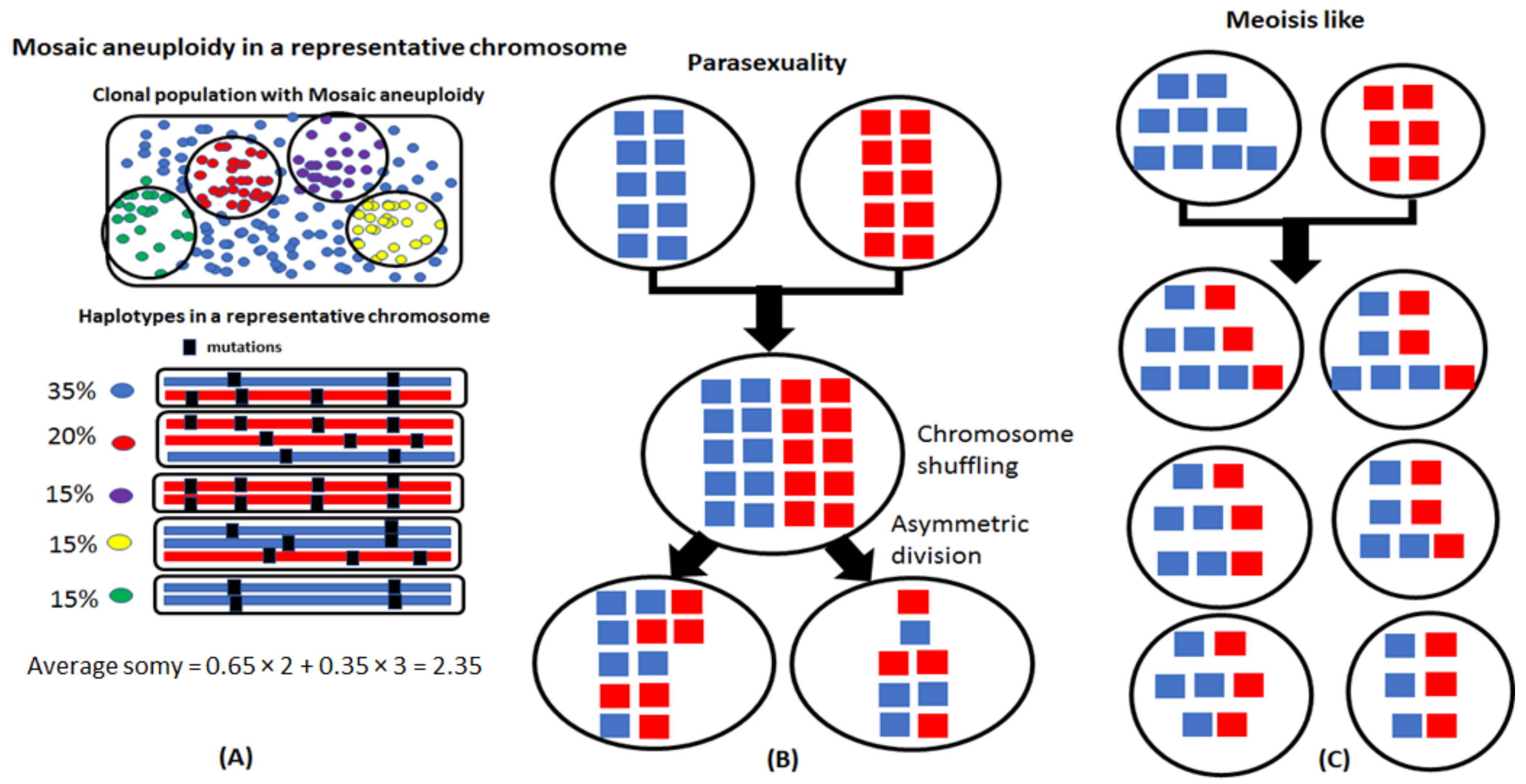
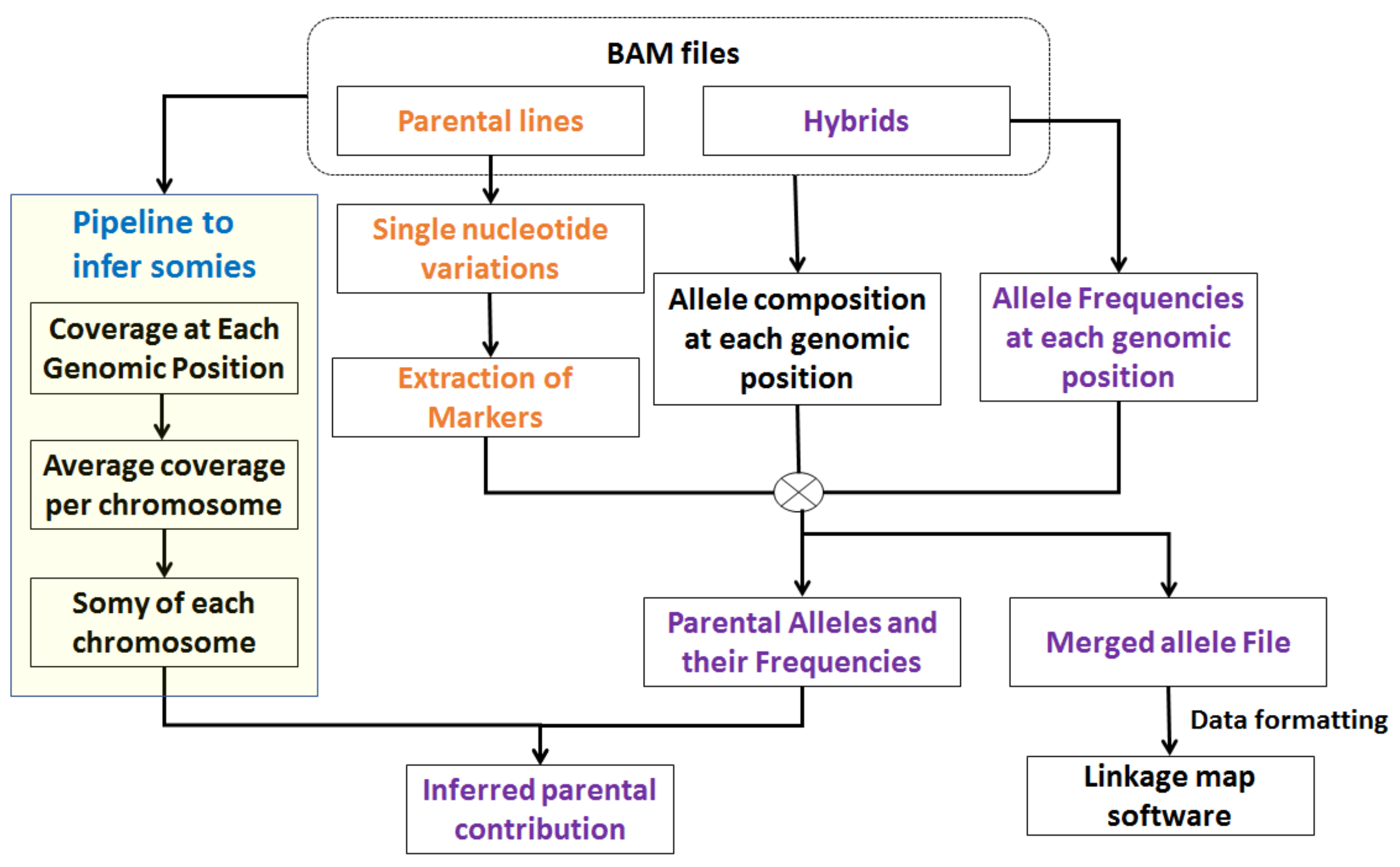
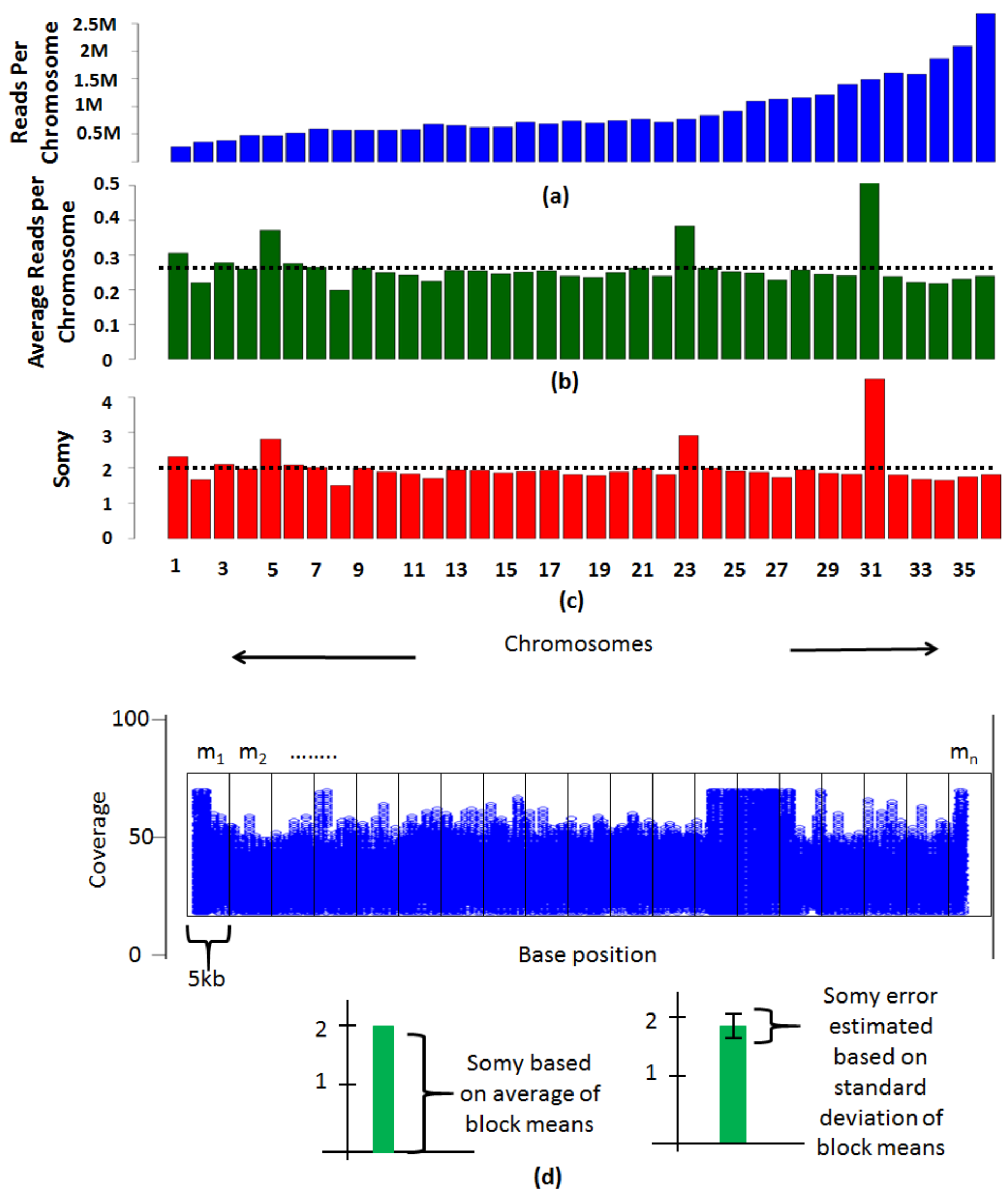
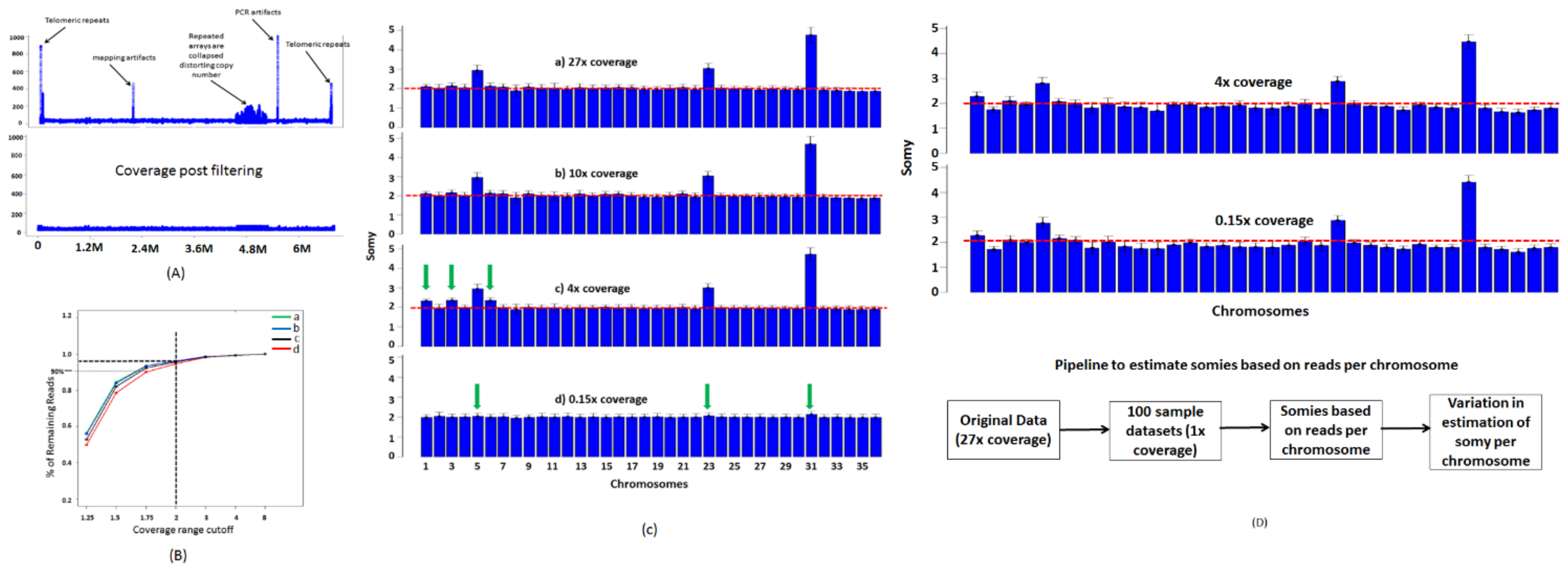
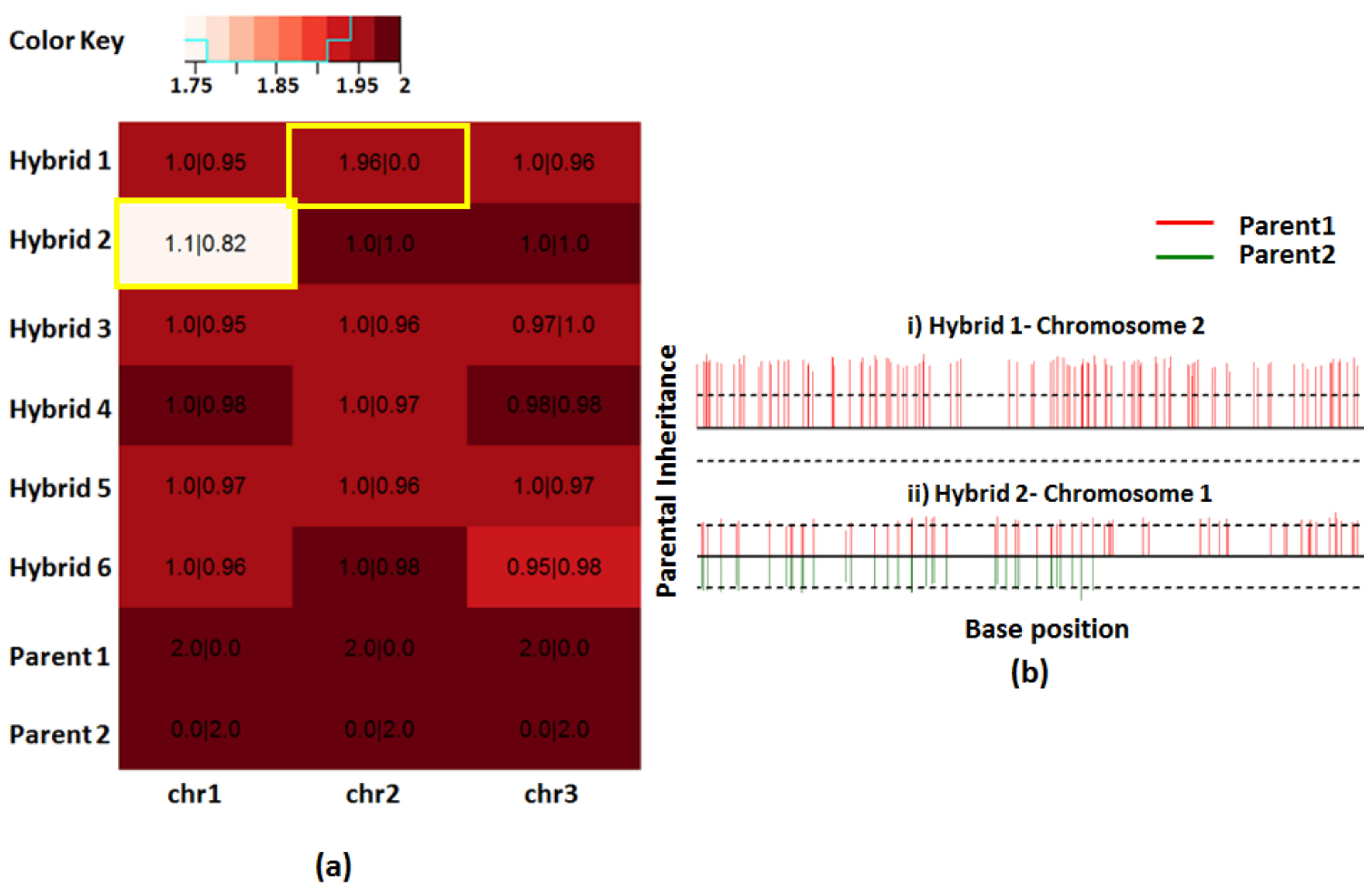
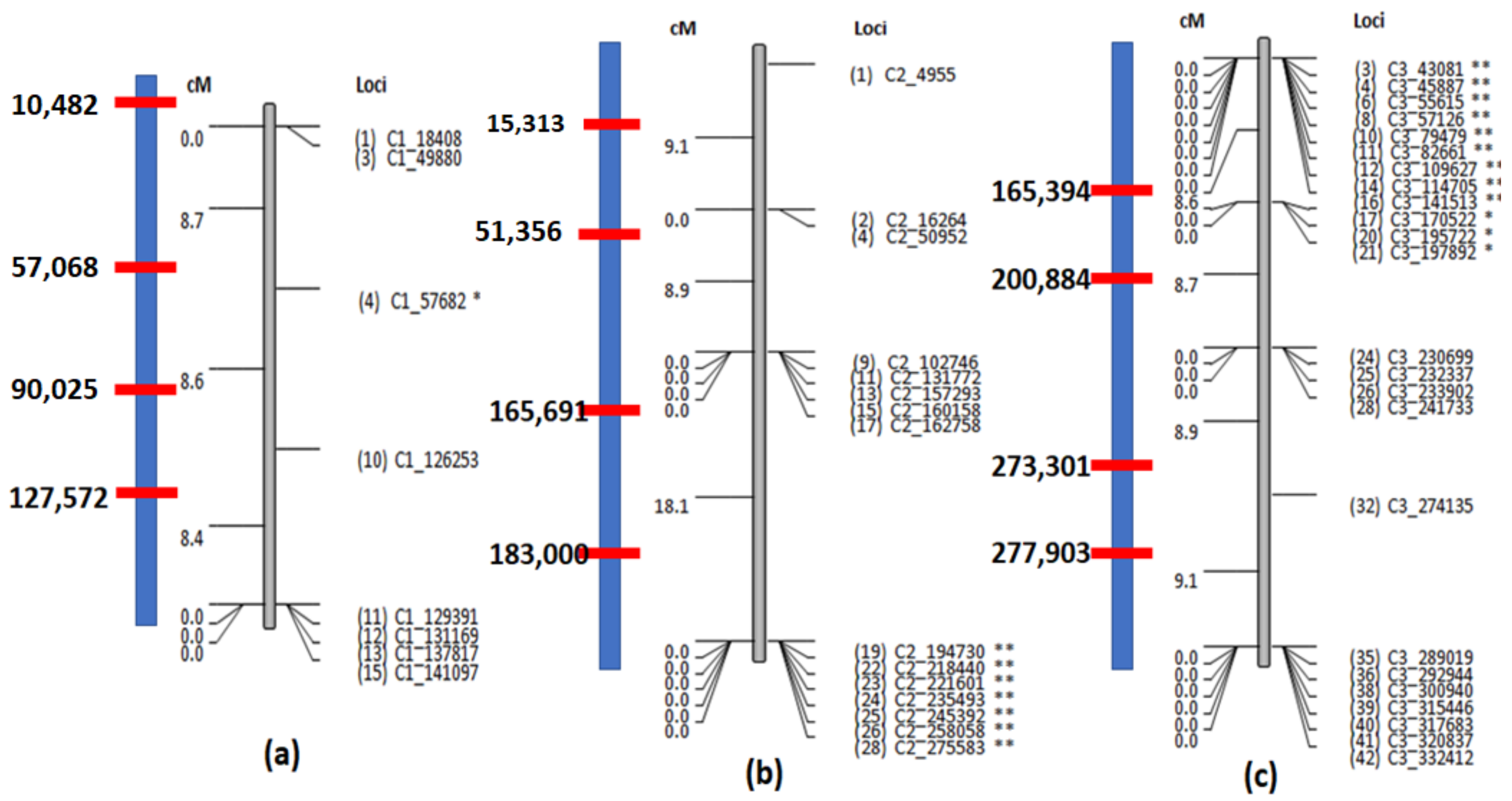
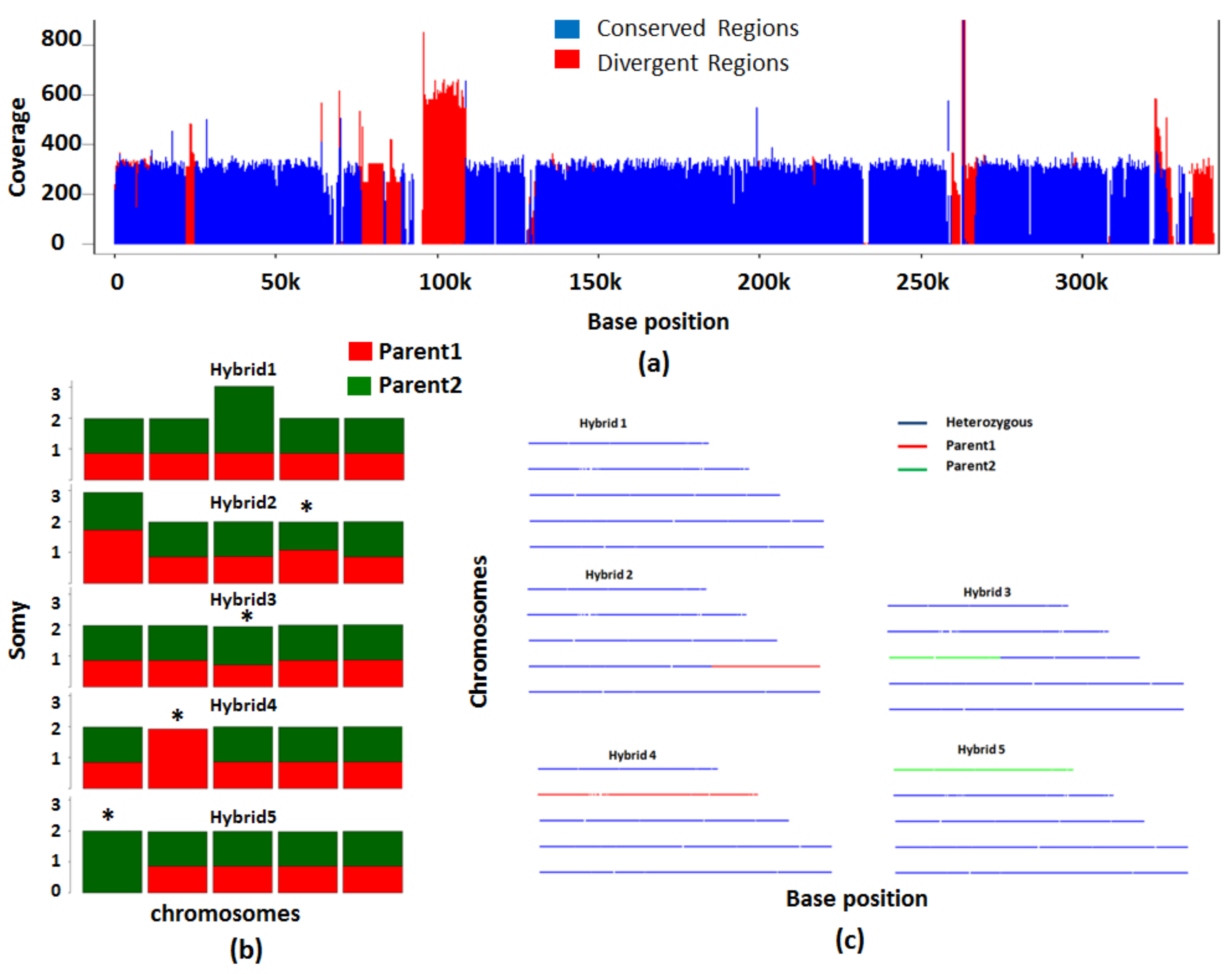
| Chr. 1 | Chr. 2 | Chr. 3 | |
|---|---|---|---|
| Hyb. 1 | 127,572 | - | 273,301 |
| Hyb. 2 | - | 165,691 | 277,903 |
| Hyb. 3 | 57,068 | 15,313 | - |
| Hyb. 4 | 10,482 | - | 200,884 |
| Hyb. 5 | - | 183,000 | 165,394 |
| Hyb. 6 | 90,025 | 51,356 | - |
| Hybrid 1 | Hybrid 2 | Hybrid 3 | Hybrid 4 | Hybrid 5 | |
|---|---|---|---|---|---|
| Chromosome 1 | 1:1 | 2:1 | 1:1 | 1:1 | 0:2 |
| Chromosome 2 | 1:1 | 1:1 | 1:1 | 2:0 | 1:1 |
| Chromosome 3 | 1:2 | 1:1 | 0.5:1 | 1:1 | 1:1 |
| Chromosome 4 | 1:1 | 1:0.5 | 1:1 | 1:1 | 1:1 |
| Chromosome 5 | 1:1 | 1:1 | 1:1 | 1:1 | 1:1 |
Publisher’s Note: MDPI stays neutral with regard to jurisdictional claims in published maps and institutional affiliations. |
© 2021 by the authors. Licensee MDPI, Basel, Switzerland. This article is an open access article distributed under the terms and conditions of the Creative Commons Attribution (CC BY) license (http://creativecommons.org/licenses/by/4.0/).
Share and Cite
Shaik, J.S.; Dobson, D.E.; Sacks, D.L.; Beverley, S.M. Leishmania Sexual Reproductive Strategies as Resolved through Computational Methods Designed for Aneuploid Genomes. Genes 2021, 12, 167. https://doi.org/10.3390/genes12020167
Shaik JS, Dobson DE, Sacks DL, Beverley SM. Leishmania Sexual Reproductive Strategies as Resolved through Computational Methods Designed for Aneuploid Genomes. Genes. 2021; 12(2):167. https://doi.org/10.3390/genes12020167
Chicago/Turabian StyleShaik, Jahangheer S., Deborah E. Dobson, David L. Sacks, and Stephen M. Beverley. 2021. "Leishmania Sexual Reproductive Strategies as Resolved through Computational Methods Designed for Aneuploid Genomes" Genes 12, no. 2: 167. https://doi.org/10.3390/genes12020167
APA StyleShaik, J. S., Dobson, D. E., Sacks, D. L., & Beverley, S. M. (2021). Leishmania Sexual Reproductive Strategies as Resolved through Computational Methods Designed for Aneuploid Genomes. Genes, 12(2), 167. https://doi.org/10.3390/genes12020167





